Dr. Timothy Bizga describes how he successfully used Traxodent® Hemodent® Paste Retraction System help capture an outstanding final impression
By: Timothy M. Bizga, DDS, FAGD
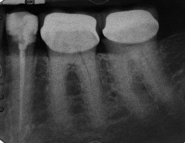 |
The pre-operative situation. Tooth No. 20 had root canal therapy and a large composite build-up. A full coverage crown was recommended, and the patient agreed. Because of the size of the build-up I was certain that a subgingival preparation would be needed and adequate tissue management for a good impression. |
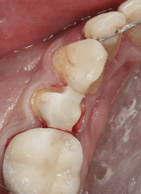 |
Occlusal view of tooth No. 20 during the early stages of crown preparation. I use Two Striper Diamonds because of their superior cutting efficiency and long-lasting cutting life (Premier® Dental). My prep sequence begins with buccal and lingual axial reduction with a flat-ended taper diamond. The key at this stage of the preparation is get below the build-up and onto sound natural tooth structure. |
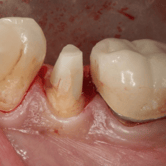 |
Buccal view of Tooth No. 20 after axial and interproximal reduction. Next, I will break interproximal contact with a thin tapered diamond, and then go back to the flat-ended taper diamond to further refine my shoulder finish line. I prefer the Two Striper Diamond 703.8C KR flat-ended taper bur because I can achieve a precise finish line while also creating rounded internal line angles. |
 |
Completed prep tooth No. 20. The final step in my prep sequence is to verify the correct amount of occlusal clearance based on the crown material. For this process I use an egg or football diamond. In this case, I was planning on a full-contour zirconia restoration so a minimum of 1mm occlusal reduction was needed. |
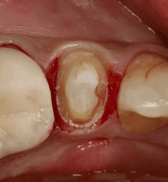 |
Occlusal view of the completed preparation on tooth No. 20. Based on the amount of sulcular fluid and blood, tissue management and hemostasis was needed. Although much of the preparation ended up being equi-gingival, there were some areas of the marginal gingiva that were traumatized during the procedure to ensure clean margins on sound tooth structure. |
 |
Traxodent paste in-place. Traxodent retraction paste was dispensed around the tooth. Even with careful dispensing, more bleeding is seen from the surrounding inflamed tissue. |
 |
Patient biting on a Retraction Cap (Premier® Dental). Retraction Caps are a dense cotton pellet and come in three sizes. In this case, I selected a #2 (medium) size Retraction Cap that fit snuggly over the tooth and when the patient bit down, forced the Traxodent in the sulcus and created direct pressure to facilitate hemostasis. |
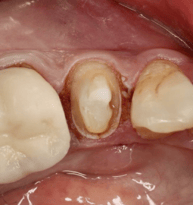 |
After Traxodent paste is rinsed away. Wow! After approximately 2 minutes, using water the Traxodent paste is completely rinsed away leaving a clean and dry prep ready for impressioning. The thing that I was so pleased about at this stage was that after the Traxodent was removed the bleeding had stopped and I was very confident my impression would turn out perfectly. |
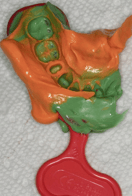 |
Final impression of tooth No. 20. Using a T-LOC Triple Tray, the final impression for tooth No. 20 was precisely captured. I really like T-LOC trays because of the retentive grooves on the side of the trays eliminating the need for tray adhesive, they are rigid to prevent distortion, and come in many shapes and sizes. |
 |
Close-up of the final impression for Tooth. 20. I am so glad I had Traxdodent when I did this case. I was able to achieve the tissue management required to capture the final impression, and no retraction cord was needed. To me this means that I did not have to pack retraction cord – a tedious and time consuming step for me – and for my patients this means that there is less chance of post-operative discomfort from the surrounding gingiva. |
About the Author:
Timothy M. Bizga, DDS, FAGD is a general dentist practicing in Cleveland, Ohio-USA. His practice focuses on comprehensive care, with Dr. Bizga’s special interests in implants, cosmetics and facial aesthetics. His background in dentistry is lengthy and diverse. Once a former chairside assistant, he also worked as a dental lab-technician, making his perspective unique among others in the field of dentistry. He graduated from Saint Louis University with a BA in Biology, before receiving his DDS from the University of Michigan School of Dentistry, at which time he was the recipient of the Francis B. Vedder award for excellence in prosthodontics. He is currently a member of the American Dental Association and the Academy of General Dentistry. He is a graduating member of the Whitecap Institute, where he received advanced implant training. Dr. Bizga is a certified John Maxwell Speaker/Trainer/Coach, a certified DISC profile trainer, clinical consultant for The Dental Advisor and
.png)
